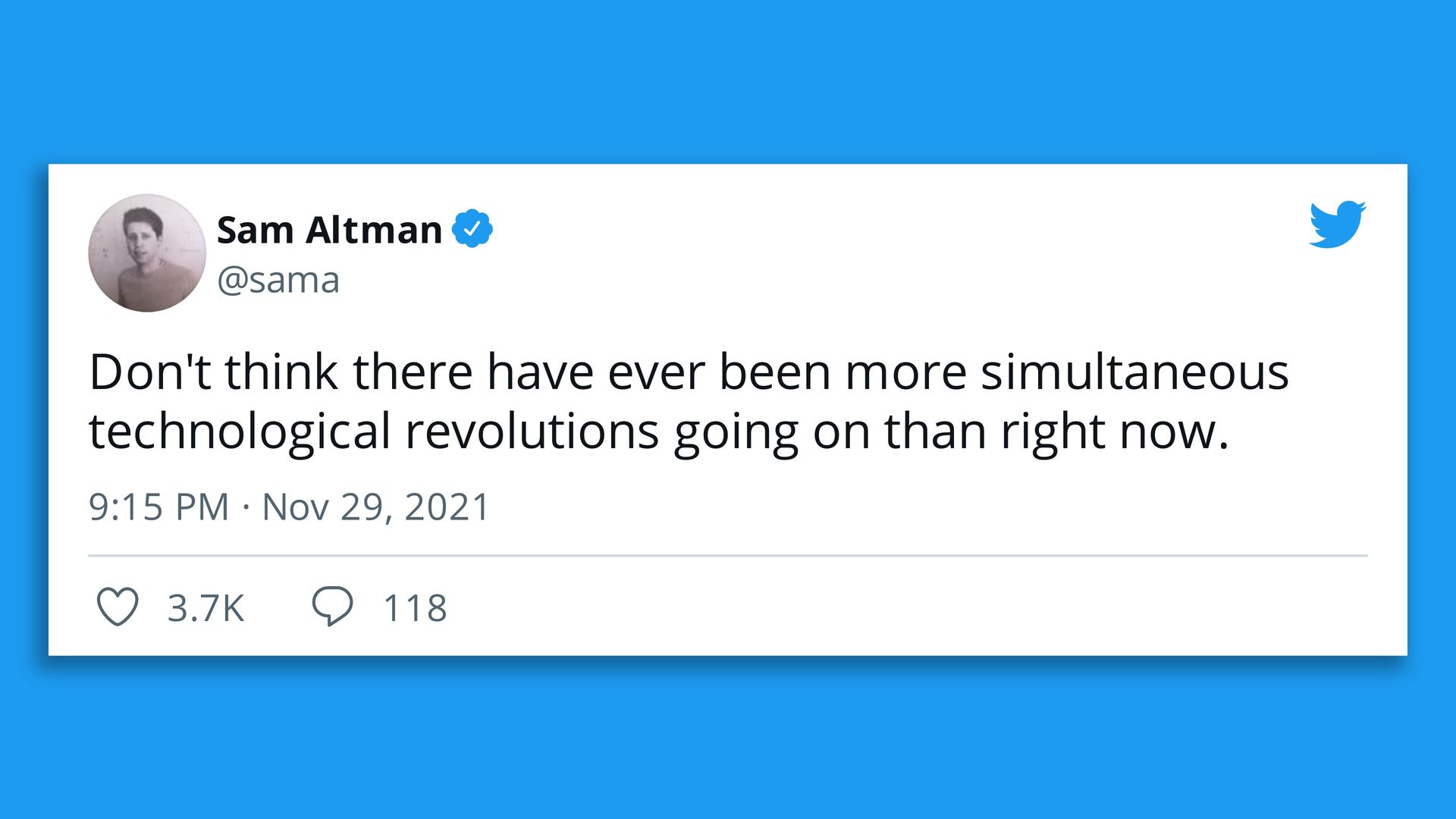| | | | | | | Presented By Barclays | | | | Axios Future | | By Bryan Walsh ·Dec 01, 2021 | | Welcome to Axios Future, where my Spotify Wrapped year-end list had a surprising number of "Frozen" and Halloween-themed kid songs thanks to a very digitally savvy 4-year-old. Today's Smart Brevity count: 1,592 words or about 6 minutes. | | | | | | 1 big thing: Omicron presages a future with more border controls |  | | | Illustration: Aïda Amer/Axios | | | | The travel bans and border closures prompted by the Omicron variant likely won't fully prevent its spread, but that won't stop countries from leaning on the measures. Why it matters: The rapid speed at which countries turned to travel bans with the emergence of Omicron indicates border controls will increasingly become a weapon against infectious disease — whether or not public health experts agree they are effective. Where it stands: 56 countries were reportedly implementing travel measures as of Nov. 28 in response to the Omicron variant, the World Health Organization reported on Tuesday. - That includes the U.S., which banned travel from South Africa — where the variant was first identified — and seven other countries in southern Africa.
- Other countries have gone further, with Japan and Israel banning all foreigners from entering their borders.
What they're saying: It's long been gospel among public health experts that targeted travel bans are unjust and largely counterproductive, which was one reason why the WHO did not recommend travel restrictions when COVID-19 was first declared a public health emergency in 2020. - Dutch health authorities announced on Tuesday they had found Omicron in virus samples dating from Nov. 19 and 23, days before South Africa first identified the variant, indicating it was already spreading in western Europe.
- Despite the U.S. travel ban, the first known U.S. Omicron case was detected in California on Wednesday.
- "Putting in place travel bans that target Africa attacks global solidarity," the WHO's regional director for Africa, Matshidiso Moeti, said on Nov. 28. "COVID-19 constantly exploits our divisions. We will only get the better of the virus if we work together for solutions."
Yes, but: The full story on travel controls is more mixed, and there is evidence that reducing the pace of international travel can at least slow the spread of a new variant — which matters at a moment when scientists still need time to understand the full extent of the Omicron threat. - A study published earlier this year found international travel measures put in place early in the pandemic were able to slow the initial export of cases outside of China.
- "Travel bans, when you have a highly transmissible virus, never completely ... prevent it from coming into the country," Anthony Fauci told ABC's "This Week" on Sunday. "But what you can do is you can delay it enough to get us better prepared."
Between the lines: Truly restrictive travel controls can all but extinguish even a virus as contagious as SARS-CoV-2. - The countries that have most effectively minimized COVID-19 cases — like Australia, New Zealand, Japan and China — have gone well beyond targeted travel bans to near full border closures.
- Scientists in China touted a study over the weekend claiming the country could be facing more than 630,000 COVID-19 infections per day if it dropped its zero-tolerance travel controls.
- But those controls have come with severe economic and social costs, and the longer the pandemic goes on, the harder it can be to maintain those measures.
The big picture: The effectiveness of travel bans may be secondary to the fact that they are a tool that governments can put in place — and just as importantly, be seen to put in place — relatively easily. Once they've been deployed, they can and will be deployed again. Read the rest. |     | | | | | | 2. A dark view of the future of autonomous weapons |  | | | A still from the video "If Human: Kill ( )." Image: Future of Life Institute | | | | A new short film warns of the coming risks posed by the development and proliferation of lethal autonomous weapons. Why it matters: Drones with the ability to autonomously target and kill without the assistance of a human operator are reportedly already being used on battlefields, and time is running out to craft a global ban of what could be a destabilizing and terrifying new class of weapon. What's happening: The Future of Life Institute (FLI), a nonprofit focused on existential risks from technology, today released "If Human: Kill ( )," a video that depicts what the future could be like if lethal autonomous weapons go unregulated. - In a word: horrific. The film splices fictional news clips to show drones and robots armed with automatic weapons using facial recognition to identify and kill political protesters and police, aid bank robberies, and assassinate scientists.
Flashback: The new film is a sequel to a 2017 video by FLI that gave a name for these autonomous weapons: "slaughterbots." - While many of the concerns about autonomous weapons focus on the possibility they could turbocharge warfare between states, or even go rogue "Terminator"-style, the FLI videos imagine a future where AI weapons fall into the hands of criminals and terrorists who can use them to wreak havoc.
- Instead of Skynet, think self-controlled and self-targeting AK-47s, a weapon that has already killed millions of people around the world.
Read the rest. |     | | | | | | 3. Major quantum computing software and hardware companies merge |  | | | The hardware chamber of a Quantinuum quantum computer. Image: Quantinuum | | | | Two major quantum computing companies — one in hardware and one in software — have merged to create a new firm called Quantinuum. Why it matters: The merger is a sign of the growing maturity of the quantum computing industry, as it begins to shift from the lab to actually solving difficult-to-compute problems in the real world. Driving the news: Honeywell Quantum Solutions, which makes quantum computers that use trapped-ion technologies, will merge with U.K. quantum software company Cambridge Quantum, the firms announced Tuesday. - Ilyas Khan, the founder of Cambridge Quantum, will serve as the CEO of the new company, while Honeywell's Tony Uttley will serve as president and COO.
- The new company says that it will be the largest integrated quantum computing company in the world, with approximately 400 staff members in the U.S. and abroad.
- "This is an opportunity for a new company to be a new center of gravity for the quantum ecosystem," says Uttley. "It's a match of best-in-class quantum software and best-in-class quantum hardware."
What's next: Quantinuum's first new offering, a quantum-focused cybersecurity product, will launch in December, to be followed next year by a quantum chemistry product. The bottom line: "People are saying that it will be 5 or 10 or 15 years before quantum computers do something useful," says Uttley. "But we think the systems that exist now are extraordinary, and we shouldn't lose sight of what's possible today." Read the rest. |     | | | | | | A message from Barclays | | Is there a case for Fedcoin? | | |  | | | | Private digital currencies are proliferating, but absent US Federal Reserve oversight they could pose a systemic risk, to say nothing of the potential threat to US dollar primacy. Should the Fed create its own digital currency in response? Barclays Research examines the options. Learn more. | | | | | | 4. How to grow the economy with biology |  | | | Illustration: Aïda Amer/Axios | | | | A new report makes the economic and environmental case for the U.S. to invest billions of dollars to build what is known as the bioeconomy. Why it matters: Transitioning to bio-based food, fuel, materials and more could sharply reduce carbon emissions and provide a foundation for a more sustainable manufacturing economy. - But while the U.S. is a world leader in biotech, it lags behind on the infrastructure and support needed to scale those innovations, the report finds.
By the numbers: A preliminary report from the Schmidt Futures Bioeconomy Task Force calculates that the biology-based economy was already generating $960 billion in economic activity in 2016 — 5% of U.S. GDP. - But should the U.S. invest billions in bioeconomy research and manufacturing, it has the potential to create more than 1 million new jobs, keep $260 billion in economic activity from going overseas, and reduce annual CO2 emissions by 450 million tons.
The catch: "What's missing is the next step, the lack of basic research into understanding the science of manufacturing and the science of biomanufacturing," says Andrea Hodgson, a fellow at Schmidt Futures and co-leader of its bioeconomy program. What to watch: The report recommends that the government invest $600 million over five years in a Bioproduction Science Initiative overseen by the National Science Foundation, as well as another $1.2 billion in bioproduction infrastructure and public-private partnerships to scale development. Read the rest. |     | | | | | | 5. Worthy of your time | | America's gambling addiction is metastasizing (Stephen Marche — The Atlantic) - One consequence of the "end of vice" — Americans have made everything into a bet.
10 million a year (David Wallace-Wells — London Review of Books) - Why air pollution is one of our deadliest and most underappreciated environmental health threats.
Inside the "misinformation" wars (Ben Smith — New York Times) - Misinformation has become a major media beat, but the truth isn't always so cut and dried.
It's time to stop demonizing "invasive" species (Marina Bolotnikova — Vox) - A controversial take on the politics of invasive species.
|     | | | | | | 6. Tweet of the day: Ahistorical edition |  | | | Screenshot: Sam Altman Twitter | | | | The head of artificial intelligence company OpenAI and "the most connected millennial in Silicon Valley" believes we may be living through an unprecedented era of innovation. Yes, but: The late 19th century would like to have a word. The big picture: No matter how transformative technologies like AI and Web3 ultimately prove, they'll be hard-pressed to beat the burst of invention that occurred near the end of the 1800s. Details: That was followed by the 1880s, a decade that historian of technology Vaclav Smil has called "perhaps the most inventive time" in history. Among the advances that decade were: - The first thermal and hydroelectricity power stations in 1882.
- The first multistory steel-skeleton skyscraper in 1885.
- The first commercial production of motor vehicles powered by internal combustion engines in 1886.
- The first electric street railway in 1887.
- The first production of electromagnetic waves in a laboratory in 1888, paving the way for wireless communication.
And don't forget: Coca-Cola, first formulated in 1886. The bottom line: We do live in a remarkable age, but that's only possible because of the fundamental inventions of the late 19th century. |     | | | | | | A message from Barclays | | Innovating to grow? Stay ahead of what's next | | |  | | | | Innovation is changing business — from spin-offs and SPACs to cutting-edge digital healthcare. See how Barclays Corporate and Investment Bank's financial insights and advice can take you to the edge of innovation and help you navigate future growth. Explore insights. | | |  | | It'll help you deliver employee communications more effectively. | | | | | | Axios thanks our partners for supporting our newsletters. If you're interested in advertising, learn more here.
Sponsorship has no influence on editorial content. Axios, 3100 Clarendon Blvd, Suite 1300, Arlington VA 22201 | | | You received this email because you signed up for newsletters from Axios.
Change your preferences or unsubscribe here. | | | Was this email forwarded to you?
Sign up now to get Axios in your inbox. | | | | Follow Axios on social media:    | | | | | |
No comments:
Post a Comment